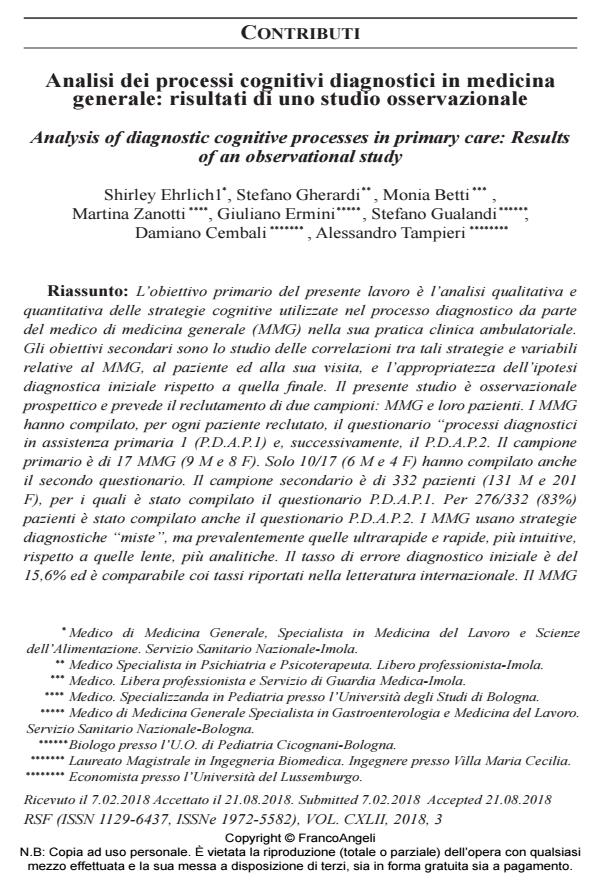Analysis of diagnostic cognitive processes in primary care: Results of an observational study
Journal title RIVISTA SPERIMENTALE DI FRENIATRIA
Author/s Shirley Ehrlich, Stefano Gherardi, Monia Betti, Martina Zanotti, Giuliano Ermini, Stefano Gualandi, Damiano Cembali, Alessandro Tampieri
Publishing Year 2018 Issue 2018/3
Language Italian Pages 31 P. 117-147 File size 1907 KB
DOI 10.3280/RSF2018-003007
DOI is like a bar code for intellectual property: to have more infomation
click here
Below, you can see the article first page
If you want to buy this article in PDF format, you can do it, following the instructions to buy download credits

FrancoAngeli is member of Publishers International Linking Association, Inc (PILA), a not-for-profit association which run the CrossRef service enabling links to and from online scholarly content.
The authors presents a qualitative and quantitative analysis of the cognitive strategies - used by general practitioners (GPs) diagnosing outpatients - and studies the correlations between the GPs’ cognitive strategies and other related variables, such as the patient and the patient visit, and the appropriateness between the initial diagnostic hypothesis and the final diagnosis. This study is prospective and observational and involved the recruitment of two samples: the GPs and their patients. For each recruited patient, the GPs filled out two questionnaires: the "Diagnostic Processes in Primary Care 1" (D.P.P.C.1) and the "Diagnostic Processes in Primary Care 2"(D.P.P.C.2). The sample of GPs comprises 17 GPs (9 M and 8 F). Only 10 GPs out of 17 (6 M and 4 F) filled out both questionnaires. The sample of patients comprises 332 patients (131 M and 201 F). 332 D.P.P.C.1 were filled out and 276 D.P.P.C.2 (83%). The GPs used "mixed" diagnostic strategies, generally ultra-rapid or rapid, intuitive strategies, and used less the slow or more analytic strategies. The initial diagnostic error rate is 15,6%, comparable to the rates reported in the international literature. GPs do less diagnostic errors using rapid methods, than ultra-rapid or slow methods (p<0,05). The authors consider critical the target of decreasing this rate, in order to increase the patient’s "safety netting". Furthermore, tools exist of proven effectiveness, e.g. debiasing techniques that counter diagnostic cognitive and affective biases.
Keywords: Diagnostic cognitive strategies, intuition, bias, diagnostic error, debias, primary care.
Shirley Ehrlich, Stefano Gherardi, Monia Betti, Martina Zanotti, Giuliano Ermini, Stefano Gualandi, Damiano Cembali, Alessandro Tampieri, Analisi dei processi cognitivi diagnostici in medicina generale: risultati di uno studio osservazionale in "RIVISTA SPERIMENTALE DI FRENIATRIA" 3/2018, pp 117-147, DOI: 10.3280/RSF2018-003007